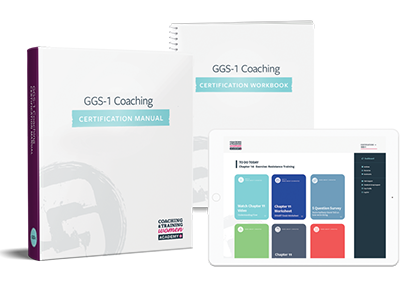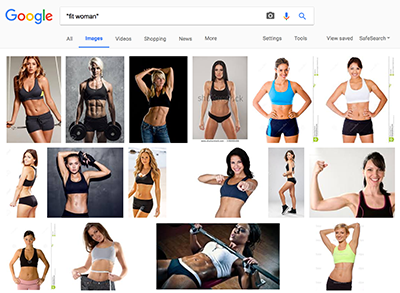If you’re a health, fitness, or nutrition professional, I bet at least one of these scenarios will sound familiar to you. (Maybe both).
Scenario A: A new client walks in and tells you exactly what she wants to “transform” into.
The bad news is that she’s showing you a picture on her phone of a celebrity who doesn’t remotely look like her (and you know how much work this celebrity had to put in to get these results). Then this new client tells you that she only has time for two 30-minute sessions per week.
Scenario B: You’ve been working with your client for a while, and she’s crushing it!
She’s getting fantastic results, and yet she’s not satisfied… ever. “I’m just not where I want to be,” she says. The more you think about it, the more you realize that her goals seem to be a moving target: she doesn’t like her arms, she wants to be leaner still, she says there’s something “wrong” with her stomach, and so on.
This can be frustrating and disheartening — for you and your client.
 Naturally, you want to set up your client to succeed. You want her to reach her goals, feel awesome, and celebrate her success. After all, that’s probably why you’re in this business in the first place — to help people.
Naturally, you want to set up your client to succeed. You want her to reach her goals, feel awesome, and celebrate her success. After all, that’s probably why you’re in this business in the first place — to help people.
Not only that, but a dissatisfied client isn’t exactly good for business. What if she starts to doubt your ability to help her? Even worse, what if she blames you when she isn’t able to get the results she was hoping for?
Luckily, there is a solution. (Spoiler alert: it doesn’t include bursting your client’s bubble or telling her she’s wrong.)
In this article, we’ll give you six strategies for reframing unrealistic client expectations so you can help your clients get out of the cycle of dissatisfaction and feel great about their results.
Why Do Women Have Such Unrealistic Expectations for Themselves?
To answer that question, try this quick game.
(This exercise is courtesy of Dr. Larissa Mercado-Lopez, associate professor at California State University–Fresno and curriculum contributor to the GGS Coaching & Training Women Academy.)
Google the words: fit woman. What do you see?
- Lean bodies
- White bodies
- Young bodies
- Bodies with no visible disabilities
- Six-pack abs and light muscle (but not “too much”)
- Sexy poses
- Trendy workout clothing like crop tops and short shorts
(Try this with “healthy woman” and you’ll get similar results. Plus lots of pictures of women laughing while eating salad.)
You don’t have to go searching for these images to see them.
Images that show how women “should” look are everywhere: on Instagram, in magazines, in celebrity culture, TV and movies, in advertising, and quite possibly even on posters and advertisements at the very gym where you work.
Of course, it’s not just the images we see. It’s also what we say and hear (and often think).
For example:
Have you ever heard someone say, “She’s too skinny! Jeez, just eat a sandwich!”
How about, “Can you believe she’s wearing that, at her size?”
Or, “A bikini!? At her age!? What is she thinking?”
These kinds of comments reveal that women’s bodies are frequently discussed, evaluated and scrutinized. Whether these conversations are about celebrities, strangers, family members, colleagues, or friends, it sends a message that women “should” look a certain way, and if they don’t, they’ll be judged and criticized.
Women are frequently judged and evaluated by their bodies.
 Women may encounter judgment and criticism about their bodies at home, work, school, in public places, and in places of health and fitness including the doctor’s office, health facilities, and the gym.
Women may encounter judgment and criticism about their bodies at home, work, school, in public places, and in places of health and fitness including the doctor’s office, health facilities, and the gym.
If we’re honest with ourselves, we coaches, trainers, and health professionals might realize that we’ve made assumptions about women based on their size (even if we haven’t meant to).
For example:
- Have you ever assumed a client was fit or capable of certain exercises because of how she looked? You may have guessed that because she was lean, she was also in good shape or had healthy eating habits. (And you might have been wrong.)
- Or, have you ever assumed that a client wasn’t fit or capable of certain exercises because of her body shape or size? Perhaps it turned out she had better cardiovascular fitness or athletic capability than you thought.
- Similarly, have you ever assumed that a female client wanted to lose weight… when that actually wasn’t her primary goal?
These are common mistakes. And they demonstrate how women are frequently judged and evaluated based on their bodies.
As a result, many women believe they “should” look a certain way.
That’s why your client expects (or hopes) to transform her body.
And she’s coming to you for help.
The thing is, you know something your client doesn’t.
You know what it takes to change a body… and it might be crystal clear to you that your client’s expectations simply aren’t realistic.
For example, achieving that “ideal” body might require…
- Significant trade-offs that don’t align with your client’s lifestyle.
- More time in the gym than she’s prepared to spend.
- Methods that don’t support her other goals or overall health.
And maybe even…
- Different genetics
Besides, in the case of some clients, it might seem like no matter what results you help them get, they’re just never going to be satisfied. They always want to lose more weight or improve some other part of their body. Their expectations keep shifting just out of reach.
So what do you do? How do you help a client set realistic expectations for herself — and love her results?
6 Strategies to Help Your Client Reframe Her Expectations
Dealing with unrealistic expectations is undeniably difficult — for you and for your client. Thankfully, there are strategies you can use to help your client see what’s realistic and healthy for her. This way, she will feel successful as she works towards her goal.
1. Take a compassionate look at your client’s concerns and apprehensions.
Your client may be unsure — perhaps even worried or fearful — about how training will change her body.
You may hear her say things like:
- “I don’t want to lift heavy weights because I don’t want to get bulky.”
- “I only want to train my abs because that’s where I want to lose weight.”
- “How will I get rid of my saddlebags if I don’t use that one machine?” (the abductor machine)
- “I don’t want to gain any muscle. I just want to tone the muscle I already have.”
(I’m sure you can think of other things you’ve heard along those same lines.)
These kinds of moments can be frustrating. But they can also present a tremendous opportunity…
If you don’t flat-out tell your client she’s wrong!
Yes, you read that right.
Instead of getting frustrated or trying to convince your client that your way is better (“I promise, you won’t get bulky!”), approach her with compassion.
Remember that she likely wants to focus on the results she hopes to achieve because she feels pressure to look a certain way.
“When helping clients through concerns or expectations that we feel are unfounded, we must remember this essential truth: to our clients, their concerns and expectations are neither foolish nor unrealistic. They may be based on lack of information or understanding of certain processes, but this does not mean your clients deserve a harsh smackdown to bring them back to reality.” — Carolina Belmares, Coaching & Training Women Academy curriculum contributor.
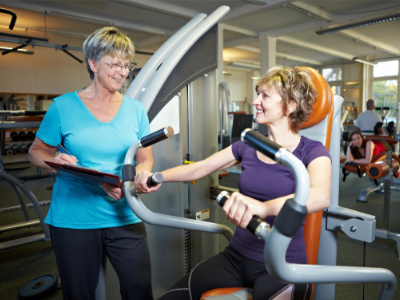 One of the worst things you can do is to dismiss your client’s concerns outright. Sure, you might know that her fears are unfounded. (Of course, she isn’t going to turn into the Incredible Hulk, especially not overnight.)
One of the worst things you can do is to dismiss your client’s concerns outright. Sure, you might know that her fears are unfounded. (Of course, she isn’t going to turn into the Incredible Hulk, especially not overnight.)
But if you ignore or dismiss her, the real message you’re sending is that you’re not receptive to her concerns.
On the other hand, if you choose to get curious and ask her questions, you create an opportunity to understand, connect with, and coach her more effectively.
Try asking questions that will help you understand where her apprehension comes from. For example:
- “Is this an experience you’ve had in the past?”
- “Can you give me examples of what you mean when you say bulky?”
- “What makes you nervous about training differently?”
Getting inquisitive helps you set the stage for a more positive interaction and gives you the opportunity to develop a stronger relationship with your client.
2. Remind your client there’s a broad range for what is considered normal.
Your client might have a very specific idea of what her results “should” look like, based on what she’s observed in other women, in fitness magazines, or on social media. She may be comparing her looks, her progress, or her performance to what she sees in others.
To help your client understand that results are never one-size-fits-all, here are a few tips you can use.
Explain to your client that the spectrum of “normal” results is very broad and varies from one individual to another.
Many factors beyond exercise and nutrition can influence results and the timeframe it takes to achieve them, including:
- Stress
- Sleep
- Hormones
- Lifestyle
- Age
- Activity levels (in and out of the gym)
- Overall health
… and more.
Use coaching cues that allow for different levels of movement and performance, without judgment or comparison.
Refrain from using cues that encourage competition and can push your clients into comparing themselves with others (e.g., “Bump up that weight, Claire! Shonda is crushing you over there using those big plates!”).
“Phrases such as ‘Choose a weight that is moderately heavy for you,’ ‘Let me know if you need a different modification,’ and ‘Work with the range of motion that your body is giving you today’ are common in my small-group classes and encourage people to focus on their own workout. ” — Kara Stewart-Agostino, Coaching & Training Women Academy curriculum contributor.
Put together a photo collection (such as an album or Instagram account) showcasing diverse client journeys.
(Make sure you’ve gotten your clients’ explicit consent, of course. That should always be required before you share any specific experiences, information, or photos).
Show your client a diverse representation of bodies and experiences to remind her that every person’s journey is a bit different. This may help her refine her own goals and expectations according to what’s realistic for her. (And it may help her broaden her own ideas of what ‘healthy’ and ‘fit’ can look like.)
As you review photos together, have a conversation. For example, you may say things like:
- “Did you know that not everyone wants to lose weight? Here are a few women who actually wanted to gain some muscle mass…”
- “Here’s an example of a few clients in their 40s who were looking to get stronger and have fewer aches and pains. You can see their results here. This woman even competed in a powerlifting meet last month and took 2nd in her class!”
These conversations can help your clients see their goals in a new light, focus on their own work, and gain a better appreciation of their unique journey.
3. Give your client an accurate “insider’s” perspective.
How much does your client truly know about what goes on behind the scenes to achieve the depictions we typically see of the commercial fitness industry or athletic competitions?
It’s easy to scroll through social media or flip through fitness magazines and remain oblivious about all that’s required to create these images of “perfect” bodies.
Remind your client that people in fitness magazines, celebrities who’ve gotten in incredible shape for a movie role, and top athletes all make their living from their bodies.
It’s their job. Their full-time job.
This means that these people:
- May train up to 30 hours a week (that’s definitely more work than your client can put in during her two or three weekly sessions).
- Get to make their bodies nearly the sole focus of everything they do by controlling every aspect of their life (food, sleep, relationships, etc.).
- Can count on the support of a full team of trainers, nutritionists, chefs, babysitters, etc.
If you’re working with a client who believes these images portray realistic goals, you can remind her of all the work that goes into creating them, including:
- A team of stylists and makeup artists whose goal is to create the most flattering looks,
- Professional photographers who craft images with perfect lighting, careful angle work, and hundreds of outtakes,
- Professional retouching to make sure the lighting and color balance is just right, and
- In many cases, additional digital enhancement of the photos (i.e., “Photoshopping”).
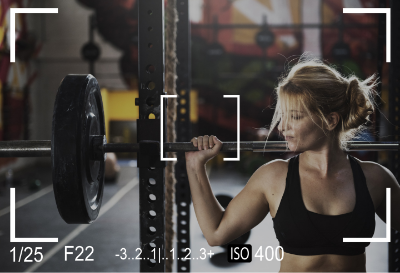 Besides, the only result we’re seeing is the one that’s crafted for the public to see. We don’t see what happens after the movie, after the photo shoot, or after the athletic event.
Besides, the only result we’re seeing is the one that’s crafted for the public to see. We don’t see what happens after the movie, after the photo shoot, or after the athletic event.
(Plus, even when celebrities share their “new healthy lifestyle” tips, we don’t know if the information they’re providing is accurate. There’s a high chance they’re simply trying to sell something.)
Sharing this information with your client can help her take a step back from those “perfect” images that seem to have become the new normal and think more critically about what she wants to achieve.
4. Encourage your client to stop consuming media that leaves her feeling bad about herself.
While looking at images of elite athletes, fitness models, or celebrities may be presented as “inspiration,” it’s usually more detrimental than helpful.
Research suggests that we feel worse about ourselves after looking at pictures of people with “ideal” bodies than after looking at “neutral” images. (This is true of both men and women, actually).
There’s a simple exercise you can encourage your client to do — and even try for yourself. Ask her to pay close attention to how she feels about her body after watching TV, reading fitness, celebrity or fashion magazines, or scrolling through social media.
If she tends to feel worse about herself, it’s time to start curating the type of media content she’s consuming. Here are some easy-to-follow suggestions:
- Every week, unfollow social media accounts or let go of a particular media outlet. Keep going until she’s no longer engaging with media that leads to comparison and negative body feelings.
- Focus on media that offers instructional or technical content and pay attention to the language used in the posts she sees. Does she notice body-shaming language hidden in there?
- Cut down on media consumption altogether and substitute other activities that make her feel better. This could be spending time outdoors, enjoying a weekly “screen-free” night with family or friends, taking a yoga class, or anything she particularly enjoys.
While, as mentioned above, exposure to certain types of media can have a negative effect, did you know that some types of media can have the opposite, positive effect?
Regularly seeing a wide variety of bodies can help us transform the way we see our own body.
By seeking out images that include a variety of bodies of all shapes and sizes, postpartum bodies, older bodies, as well as bodies of different races and abilities, we broaden the definition of what we find acceptable, attractive, or beautiful.
Representation is important.
You can steer your client toward social media accounts and media outlets that offer a more diverse representation of bodies and experiences. Make sure these bodies differ from what is traditionally represented in the media.
5. Celebrate your client’s efforts and vary your words of encouragement.
 Results can be hard to control. Many factors come into play, so holding firm expectations about outcomes can set your client up for disappointment.
Results can be hard to control. Many factors come into play, so holding firm expectations about outcomes can set your client up for disappointment.
By helping her focus on what she can control, she can commit to doing her very best every day with what’s available to her, and she can find ways to enjoy the process.
What small wins can you acknowledge and help your client see?
Objectively, what progress is she making? Which areas, other than her appearance, can you emphasize?
- Is she leading by example by always showing up on time and having a positive effect on the other participants in the class?
- Is she refusing to let her busy schedule detract them from showing up to her workout sessions?
- Does she try new things, despite her initial discomfort, or despite the fear that she’ll look foolish or be “bad” at it?
- Does she encourage others in class and promote the spirit of teamwork you’re trying to cultivate?
- Is she learning to cook new things so that her nutrition is more aligned with their goals?
- Is she moving her body in new ways or noticing a difference in the way she carries herself?
- Does she include new healthy habits in her daily life in a way that’s starting to feel like second nature?
- Does she find herself using new strengths she’s just discovered or superpowers she forgot she had?
“In my classes, I make sure that I encourage and compliment each individual woman on the progress she’s making — even if it is small. ‘Wow, Jane! Your balance is getting so much better! Good job, Sarah! You are getting out that second set now!’ I never comment on body shape or size, but rather on effort or performance. This creates a culture in the class that does not support too much comparison.” — Marika Hart, Coaching & Training Women Academy curriculum contributor.
Help your client notice and appreciate her own progress markers.
Learning to recognize these small wins and taking the time to celebrate them is a wonderful way to stay present and active in the process — and to keep unrealistic expectations in check.
It’s also a good idea for you to model this so that your client can see that these small wins count for everyone. For example, your client may dismiss adding five pounds to a lift, saying it’s “no big deal,” but if you share how happy you are that you were able to add five pounds to one of your lifts, it will help her put her own achievements into a healthier perspective.
6. Lead by example.
What you say and do has the power to set the right tone and develop a culture that’s positive and inclusive. That’s true whether you’re working one-on-one with clients, teaching in a commercial gym setting, in large-group environments, or even in remote coaching.
Create and enforce a policy with no tolerance for criticizing, shaming, or bashing anyone’s body. (This includes not criticizing your own body.)
Make it clear that negative comments about bodies aren’t acceptable and will not be tolerated. Be compassionate but firm about this.
However, make sure your clients know that if they have negative feelings about their body, your door is always open for a private conversation where they can share how they’re feeling.
Your goal shouldn’t be to make your clients afraid to express how they feel but to help them become aware of the words they use.
When you witness body criticism, shaming, or bashing, use the opportunity to teach clients to reframe what they’re saying and find a positive area on which to focus instead. (“I hear that you’re not feeling great right now, but have you noticed how much your squat form has improved? Do you remember how challenging it was for you a few months ago? Your progress is incredible!”)
Whenever possible, use a wide variety of images in your gym, on your website and social media posts, and in your marketing materials.
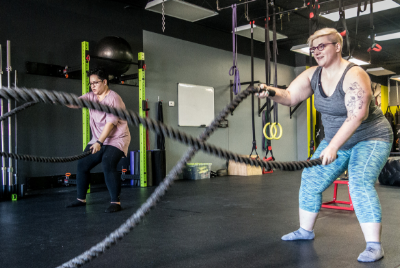 Pay extra attention to the images you’re using in your space, in your signage, on your website, and in social media.
Pay extra attention to the images you’re using in your space, in your signage, on your website, and in social media.
Remember that these images also set the tone and give you the opportunity to visually express that you welcome and support all bodies and all types of goals.
Creating a culture in which your clients develop realistic expectations, get great results, and feel fantastic about their progress (with your help)… now that is real leadership.
Isn’t that the coach you want to be?
If you’re a health, fitness, or nutrition professional (or you want to be)…
Learning how to coach clients, patients, friends, or family members through delicate issues — like negative body image, comparing themselves to others, or having unrealistic expectations — is both an art and a science.
If you’d like to learn more about both, consider enrolling in our GGS Level 1 Certification, which opens for enrollment VERY soon.
Learning how to properly coach women could transform your career — and change the lives of your clients.
And our Girls Gone Strong Level 1 Certification is the most respected coaching certification in the world for working with women.
Most coaches and trainers don’t realize that coaching women is different from coaching men.
The truth is, coaching women requires a different set of skills and knowledge that goes beyond understanding the anatomical differences.
This certification gives health, fitness, and nutrition professionals — and aspiring professionals — the skillset, knowledge, and toolkit they need to successfully and confidently coach women.
Our Coaching and Training Women Academy has certified thousands of professionals in 60+ countries around the world. Their results have been astonishing.
Now, we’re offering all that knowledge and training to you.
Interested? Add your name to our no-obligation pre-sale list. You’ll save up to 33% and secure your spots 24-48 hours before the public.
On April 16th, 2019 we’re opening enrollment to our GGS Level 1 Certification to a limited number of students.
To learn more, check out our pre-sale list which gives you two huge advantages:
- You’ll pay less than everyone else. The students who are most eager to level up their coaching skills are our most successful students, so we like to reward those who join the pre-sale list by offering a discount of up to 33% off the general price.
- You’ll get to enroll early. We only open enrollment twice per year, and spots always sell out FAST. By joining the pre-sale list, you have the chance to enroll 24-48 hours before the general public, increasing your chances of getting a spot.
Women are tired of people who “don’t get it.”
They’re looking for health, fitness, and nutrition pros who understand them, know how to support them, and are committed to making a REAL difference to their health.
And our GGS Level 1 Certification is the solution. This is your chance.
Stand out. Build a thriving career. And make the kind of difference you were born to make.
